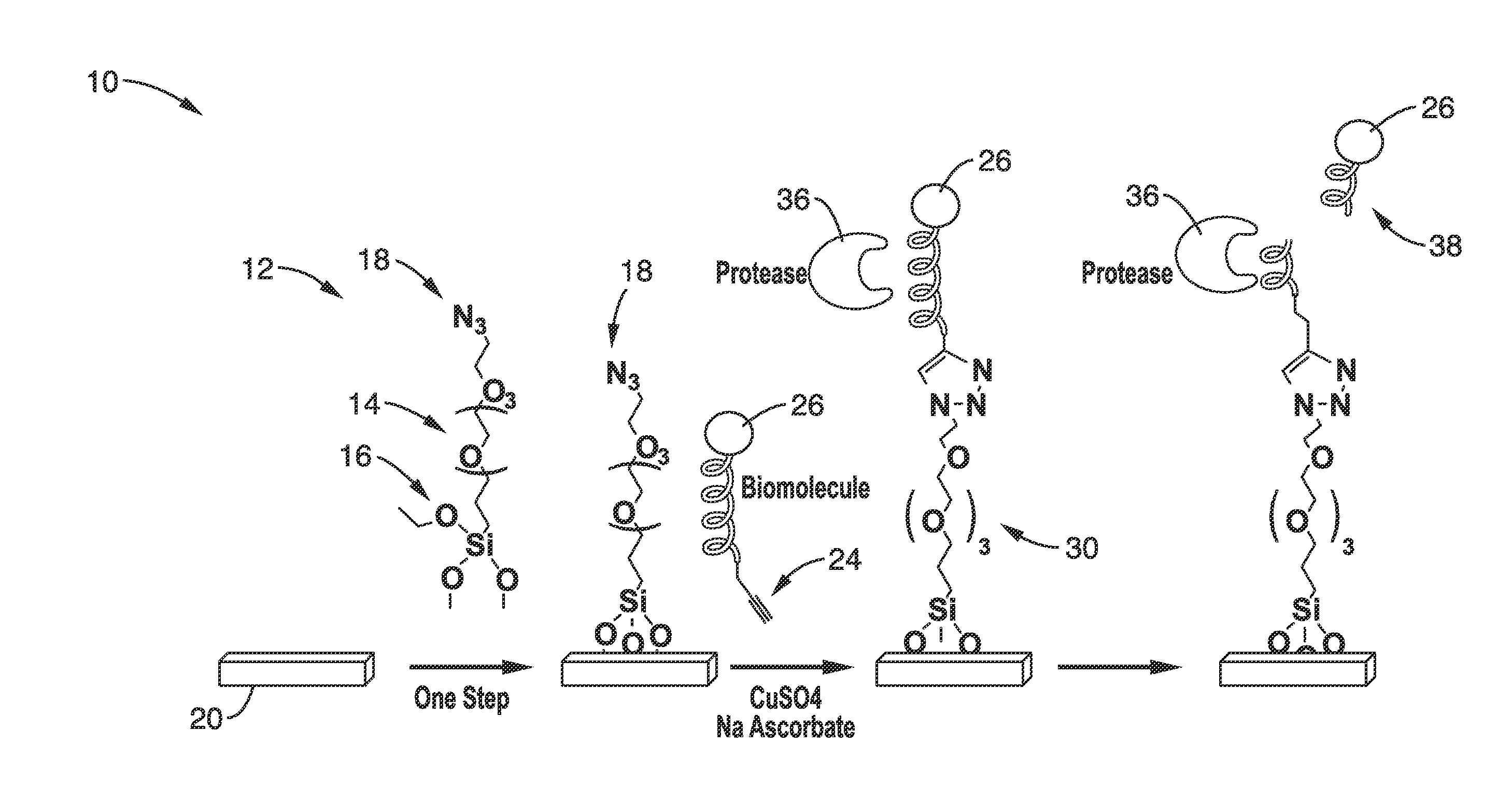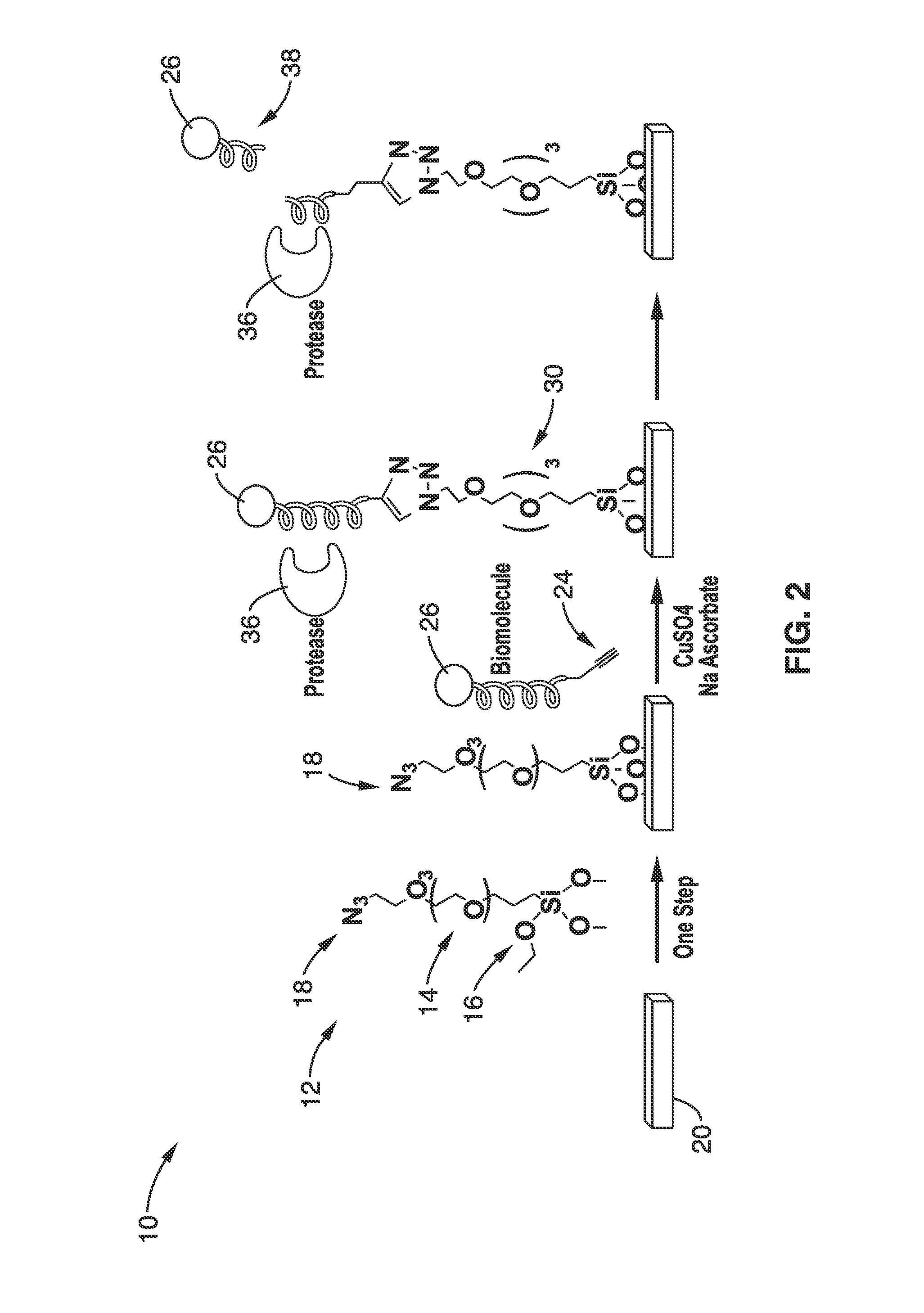Bioconjugation using bifunctional linkers
a bifunctional linker and bioconjugation technology, applied in the field of surface functionalized substrates and microarray fabrication methods, can solve the problems of low efficiency of in situ peptide synthesis, limiting the use of large-scale fabrications, and inevitably having a substantial negative effect on peptide activity, etc., to achieve the reproducibility and sensitivity necessary for sensitive, reliable activity-based assays, and achieve high yields. , the effect of high requirements for displaying bio
- Summary
- Abstract
- Description
- Claims
- Application Information
AI Technical Summary
Benefits of technology
Problems solved by technology
Method used
Image
Examples
example 1
[0060]In order to demonstrate the invention, a synthesis scheme for one embodiment of a bifunctional reagent was produced and evaluated. The synthesis scheme of a bifunctionalized triethoxysilane derivative embodiment is illustrated in FIG. 3. Generally, the bifunctionalized reagent (Compound 5) of FIG. 3 is synthesized from the starting material tetraethylene glycol 40. The allyl group is introduced by a desymmetrization reaction with allyl bromide 44 in basic conditions. The free hydroxyl group was converted into the azide group by treating with carbon tetrabromide 48 and sodium azide 56, sequentially. Hydrosilylation is finally carried out using triethoxysilane 60 in the presence of a Karstedt catalyst 62 to obtain a silane (Compound 5) with the azide group intact. Hydrosilylation of the double bond is performed in the last step to avoid unnecessary hydrolysis and condensation reactions of the labile triethoxysilane functionality. The silane (Compound 5) and intermediates that we...
example 2
[0066]In order to demonstrate the single step functionalization of a substrate and peptide immobilization illustrated in FIG. 1, the Compound 5 linker 64 was prepared using the scheme of FIG. 3 and used on a glass slide substrate.
[0067]Step 1. Hydration of the glass slide surfaces: The glass slides were dipped in piranha solution (5:1 H2SO4 / H2O2) for overnight and rinsed with deionized water. The glass slides were then dried under Argon gas.
[0068]Step 2. Silanization with Compound 5: The solution of compound 5 in toluene was filtered by PTFE filter (Fisherbrand, 0.45 μm). The glass slides were dipped in a 10 mM solution of compound 5 in toluene for overnight storage at room temperature. The slides were then washed with toluene, ethanol, THF, and deionized water, then in the reversed order.
[0069]The bifunctional reagent 64 (Compound 5) was then conjugated onto the glass surfaces in toluene solution. The silanization step was followed by a curing at 80° C. for 3 hours to stabilize the...
example 3
[0077]In order to monitor bioconjugation efficiencies and bioactivities with the NBD-containing peptide, a bifunctional peptide with NBD at the C-terminus and an alkyne group at the N-terminus was produced. The alkyne group was conjugated onto a glass surface bearing an azide group using click chemistry and the surface-bound peptide was detected by a microarray scanner.
[0078]Furthermore, a fluorescent peptide substrate for trypsin, which can be cleaved at the carboxyl side of the amino acids lysine and arginine, was also conjugated to the surface by this procedure. Accessibility of the peptide on the surface to enzymatic reactions was demonstrated by its ready cleavage by trypsin. No cleavage was detected when BSA was used as a control. Enzyme activity was easily observed by a decrease of fluorescence on the surface image. Importantly, no blocking step was needed after peptide conjugation or before protease digestion. It is likely that the azide group on the glass surface was inert ...
PUM
| Property | Measurement | Unit |
|---|---|---|
| temperature | aaaaa | aaaaa |
| θ | aaaaa | aaaaa |
| pH | aaaaa | aaaaa |
Abstract
Description
Claims
Application Information
 Login to View More
Login to View More - R&D
- Intellectual Property
- Life Sciences
- Materials
- Tech Scout
- Unparalleled Data Quality
- Higher Quality Content
- 60% Fewer Hallucinations
Browse by: Latest US Patents, China's latest patents, Technical Efficacy Thesaurus, Application Domain, Technology Topic, Popular Technical Reports.
© 2025 PatSnap. All rights reserved.Legal|Privacy policy|Modern Slavery Act Transparency Statement|Sitemap|About US| Contact US: help@patsnap.com



